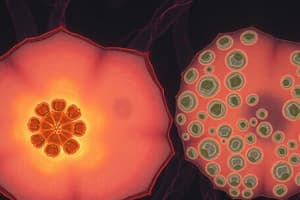Podcast
Questions and Answers
What is the role of active transport in plants?
What is the role of active transport in plants?
- It facilitates nutrient diffusion from roots to leaves.
- It allows plants to absorb water only.
- It prevents excessive ion absorption.
- It helps plants take in necessary ions from the soil. (correct)
How does glucose absorption occur in the intestines when glucose concentration is lower outside the cells?
How does glucose absorption occur in the intestines when glucose concentration is lower outside the cells?
- Glucose flows passively into blood vessels.
- Glucose is not absorbed in this situation.
- Glucose diffusion takes place without energy.
- Active transport is utilized, requiring energy. (correct)
Which process requires energy for the movement of substances?
Which process requires energy for the movement of substances?
- Diffusion
- Active transport (correct)
- Facilitated diffusion
- Osmosis
What is the main difference between diffusion and active transport?
What is the main difference between diffusion and active transport?
Which substances typically move by diffusion?
Which substances typically move by diffusion?
What energy source is used for active transport in animals?
What energy source is used for active transport in animals?
What distinguishes osmosis from active transport?
What distinguishes osmosis from active transport?
In which scenario is active transport NOT needed for glucose absorption?
In which scenario is active transport NOT needed for glucose absorption?
Which of the following correctly describes the procedure for setting up the experiment with potato chips?
Which of the following correctly describes the procedure for setting up the experiment with potato chips?
What is the purpose of weighing the potato chips before and after immersion in sugar solutions?
What is the purpose of weighing the potato chips before and after immersion in sugar solutions?
After conducting the experiment, what is inferred if the potato chips gained weight in sucrose solutions?
After conducting the experiment, what is inferred if the potato chips gained weight in sucrose solutions?
If potato chips are placed in a solution with lower concentration than their internal cellular environment, what would most likely happen?
If potato chips are placed in a solution with lower concentration than their internal cellular environment, what would most likely happen?
How is the percentage weight change calculated from the experiment?
How is the percentage weight change calculated from the experiment?
Which of the following statements best explains osmosis in the context of the experiment?
Which of the following statements best explains osmosis in the context of the experiment?
What role does concentration gradient play in this experiment?
What role does concentration gradient play in this experiment?
What conclusion can be drawn from the graph plotting percentage weight change against sucrose concentration?
What conclusion can be drawn from the graph plotting percentage weight change against sucrose concentration?
What primarily drives the movement of glucose through the dialysis tube in the experiment?
What primarily drives the movement of glucose through the dialysis tube in the experiment?
Why is starch unable to pass through the dialysis tubing used in the experiment?
Why is starch unable to pass through the dialysis tubing used in the experiment?
What is the best definition of semi-permeable as illustrated in this experiment?
What is the best definition of semi-permeable as illustrated in this experiment?
In what way does this experiment model the absorption in the small intestine?
In what way does this experiment model the absorption in the small intestine?
Which solution is used to test for the presence of glucose in the water around the dialysis tube?
Which solution is used to test for the presence of glucose in the water around the dialysis tube?
What best distinguishes diffusion from osmosis in the context of this experiment?
What best distinguishes diffusion from osmosis in the context of this experiment?
Which of the following describes the main result expected after testing the water surrounding the dialysis tube for glucose?
Which of the following describes the main result expected after testing the water surrounding the dialysis tube for glucose?
What essential factor must be maintained in the experiment for diffusion to occur effectively?
What essential factor must be maintained in the experiment for diffusion to occur effectively?
Flashcards are hidden until you start studying
Study Notes
Active Transport in Plants and Animals
- Active transport allows plants to absorb necessary ions from the soil against concentration gradients.
- In animals, glucose is absorbed through the gut wall into the bloodstream, even when glucose concentration is lower in the intestine compared to intestinal cells.
- Active transport of glucose requires energy from respiration, particularly after low glucose conditions.
Comparison of Transport Mechanisms
- Diffusion: Movement of particles from high to low concentration without energy.
- Substances involved: carbon dioxide, oxygen, water, nutrients.
- Osmosis: A specialized form of diffusion for water across a selectively permeable membrane, no energy required.
- Active Transport: Movement of substances against a concentration gradient, requires energy.
Experiment: Diffusion of Starch and Glucose
- Aim: Observe diffusion of starch and glucose through a semi-permeable membrane.
- Equipment used: dialysis tube, beaker of warm water, glucose/starch solution, iodine solution for starch, Benedict’s solution for glucose test.
- Method involves filling a dialysis tube with a solution, immersing it in warm water, and testing for glucose and starch after a set time.
Experiment Results and Analysis
- Glucose test can demonstrate if glucose diffused through the dialysis tube by changing color with Benedict’s solution.
- Starch, being a larger molecule, cannot pass through the dialysis tubing, illustrating semi-permeability.
- Semi-permeable membranes allow certain substances to pass while blocking others.
Understanding of Osmosis through Additional Experiment
- Potato chips placed in sugar solutions of varying molarity analyze osmosis effects.
- Changes in weight of potato chips are recorded to assess water movement through osmosis.
- Percentage weight change calculated gives insights into water concentration inside potato cells.
Conclusion
- Observing diffusion and osmosis through experiments helps understand nutrient absorption in organisms.
- Semi-permeable membranes play a crucial role in regulating which substances enter or leave cells.
Studying That Suits You
Use AI to generate personalized quizzes and flashcards to suit your learning preferences.




